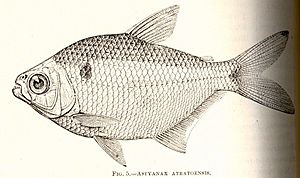Astyanax atratoensis facts for kids
Quick facts for kids Astyanax atratoensis |
|
|---|---|
 |
|
| 1907 illustration | |
| Conservation status | |
| Scientific classification | |
| Genus: |
Astyanax
|
| Species: |
atratoensis
|
The Astyanax atratoensis is a small, shiny freshwater fish. It lives in the Atrato River basin in Colombia. This fish was first found in a smaller river called the Truandó River. Its name, atratoensis, comes from the Atrato region.
Even though this fish is not currently in danger, its home rivers have faced a lot of pollution from human activities. Because of this, several groups have started projects to clean up and restore these important waterways.
This fish lives in both low and high places along the river. They have changed over time to fit their surroundings. Fish from higher places have deeper bodies than those from lower places. But their colors are the same: mostly silver, with a shiny silver stripe along their side. They also have a small dark spot near their tail. Another oval-shaped dark spot on their shoulder helps tell them apart from similar fish.
Contents
What is the Astyanax atratoensis?
The Astyanax atratoensis is a type of fish first described in 1907. It was discovered by a famous German-American fish scientist named Carl H. Eigenmann. He published his findings in a science journal. Another fish scientist, Fletcher Ogle, helped him write the article.
Scientists often group fish that are similar. The A. atratoensis is closely related to another fish called Astyanax caucanus. This fish was named by an Austrian scientist in 1879. The A. atratoensis also belongs to a larger group of Astyanax species.
Where did the name Astyanax come from?
The name A. atratoensis comes from the Atrato River basin in Colombia, where it lives. The name for its genus, "Astyanax," is a bit more mysterious. It likely refers to Astyanax, a brave warrior from the ancient Greek story, Homer's Iliad. He was the son of Prince Hector of Troy. One idea is that the scales of the first Astyanax fish found were large and silvery, like a warrior's armor or shield.
How does the Astyanax atratoensis look?
The Astyanax atratoensis has a somewhat diamond-shaped body. It usually grows to about 10.3 cm (4.1 inches) long. However, some fish from a certain part of the Atrato River have been found to be much larger, up to 21.5 cm (8.5 inches) long.
This fish is mostly a shiny silver color. It has a clear, oval-shaped dark spot on its shoulder that is taller than it is wide. A silver stripe runs along its side and ends in a small dark spot near its tail.
The number of rays in its anal fin (the fin on its belly) can be between 35 and 39. This can help scientists tell it apart from other similar fish. Its dorsal fin (on its back) has 10 to 11 rays. Even though their bodies can look a bit different depending on where they live, these differences are not big enough to confuse them with other fish species.
Where does the Astyanax atratoensis live?
The Astyanax atratoensis only lives in the Atrato River basin in Colombia. It was first discovered in the Truandó River, which is part of this basin. You can find this fish in both high and low parts of the river system.
The environment where a fish lives can change how its body looks. For example, A. atratoensis living in higher places have deeper bodies. Fish from lower places have a more streamlined shape. Scientists are still trying to figure out why this happens. They think it might be because of differences in the plants along the riverbanks, how fast the water flows, or the risk of being eaten by birds.
Other fish in the Astyanax family often eat many different things. They can eat plants and small animals. They also eat material that falls into the water from outside the river. We don't know much about what the A. atratoensis specifically likes to eat.
Is the Astyanax atratoensis in danger?
The IUCN (International Union for Conservation of Nature) says that the Astyanax atratoensis is a species of "least concern." This means it is not currently endangered. Even though it lives in a specific area, there are no immediate threats to its numbers.
However, the Atrato River basin, where it lives, has faced serious pollution problems. But good news! In 2016, a court in Colombia made an important decision. They said the Atrato River should be treated like a living being that deserves protection and restoration. This was a new way to think about conservation. Since then, the Colombian government has started some cleanup and conservation projects. More big plans are still being worked on.
See also
 In Spanish: Astyanax atratoensis para niños
In Spanish: Astyanax atratoensis para niños


